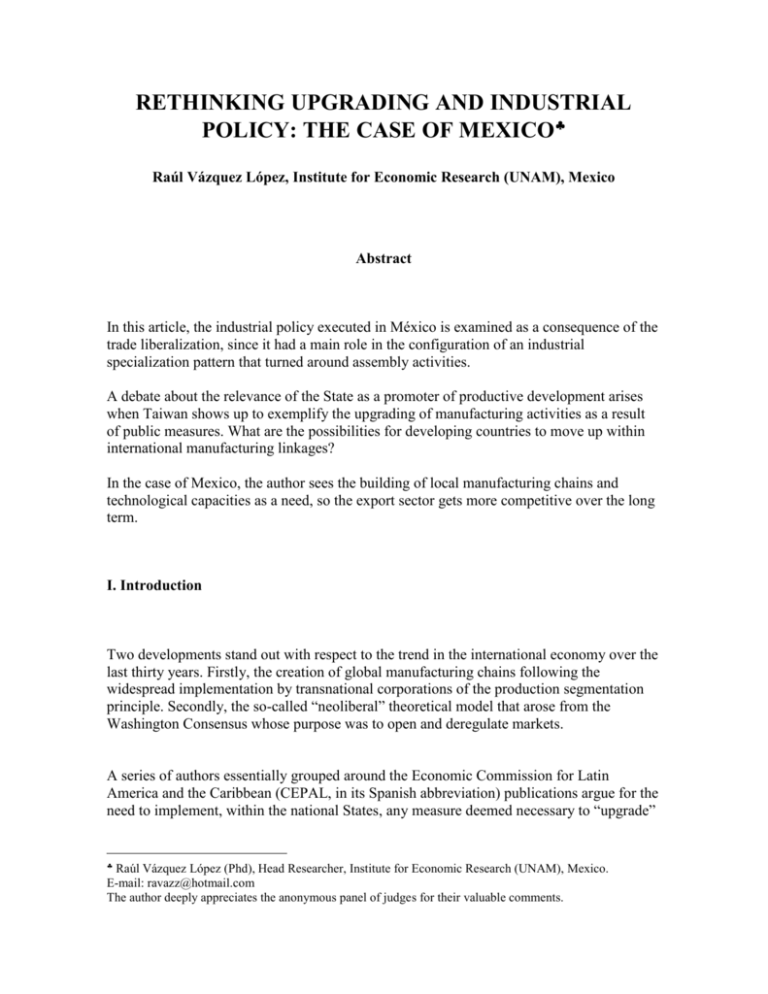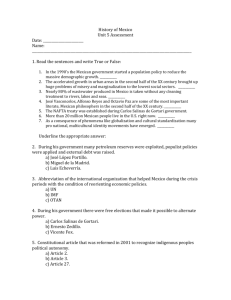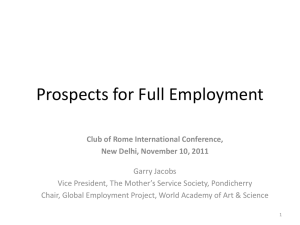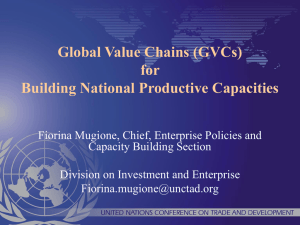lopez
advertisement

RETHINKING UPGRADING AND INDUSTRIAL POLICY: THE CASE OF MEXICO Raúl Vázquez López, Institute for Economic Research (UNAM), Mexico Abstract In this article, the industrial policy executed in México is examined as a consequence of the trade liberalization, since it had a main role in the configuration of an industrial specialization pattern that turned around assembly activities. A debate about the relevance of the State as a promoter of productive development arises when Taiwan shows up to exemplify the upgrading of manufacturing activities as a result of public measures. What are the possibilities for developing countries to move up within international manufacturing linkages? In the case of Mexico, the author sees the building of local manufacturing chains and technological capacities as a need, so the export sector gets more competitive over the long term. I. Introduction Two developments stand out with respect to the trend in the international economy over the last thirty years. Firstly, the creation of global manufacturing chains following the widespread implementation by transnational corporations of the production segmentation principle. Secondly, the so-called “neoliberal” theoretical model that arose from the Washington Consensus whose purpose was to open and deregulate markets. A series of authors essentially grouped around the Economic Commission for Latin America and the Caribbean (CEPAL, in its Spanish abbreviation) publications argue for the need to implement, within the national States, any measure deemed necessary to “upgrade” Raúl Vázquez López (Phd), Head Researcher, Institute for Economic Research (UNAM), Mexico. E-mail: ravazz@hotmail.com The author deeply appreciates the anonymous panel of judges for their valuable comments. within the international manufacturing linkages in order to position themselves in the most profitable segments of the chains (CEPAL, 2008). The purpose of this article, then, is to present some general elements of analysis in order to discuss this proposal and work on a response to several questions that arise from it: Is it possible for emerging countries to move up within international value chains in the current global economic environment? Is a complete break with the prevailing theoretical paradigm necessary? If so, what guidelines should be included in an alternative industrial development policy for countries such as Mexico? After outlining the main guidelines of the industrial policy implemented in Mexico after the 1990s and its consequences for the manufacturing sector, the second part of this article looks at a relative success story: industrial development measures adopted by Taiwan. The third part makes a critical appraisal of the feasibility of “upgrading” within international value chains for emerging economies overall. Finally, the conclusion attempts to respond to questions raised at the beginning, and mentions some general aspects that an alternative public policy might consider. II. Analysis and results of Mexican industrial policy In Mexico, the industrial policy of the second half of the 1980s and 1990s was essentially horizontal in nature (measures directed at all sectors) and its main purpose was to develop the export inbond industry and to make its global insertion easier. Based on the premise that trade liberalization and economic globalization implied that development policies could not be designed independently of measures aimed at boosting foreign trade, the authorities began to eliminate in practice sectorial development instruments. As such, the industrial specialization pattern resulting from the aforementioned measures encouraged the inclusion of the local productive industry in sectors of high capital content but controlled by large transnational corporations with global organizational strategies. As there was no room for them in these linkages, domestic activities traditionally related to technological progress, among others, were progressively pushed out of the market, victims of trade liberalization and the related public policy (Villagómez, 2003). The reshuffling of the country’s manufacturing production as a function of global production needs therefore occurred through the greater specialization of exporters in end segments of the value chain and through the displacement of local production by imports. It should be recalled that the end segments of these global chains are usually comprised of assembly activities and characterized by low domestic technological knowledge content. The bias of the measures enforced has in fact systematically placed non-exporting companies at a clear disadvantage, which has caused both the concentration of the current productive structure in a small number of sectors and the cancellation of industrial specialization alternatives. The failure of Mexico’s industrial policies can then be found in the general lack of technological progress in Mexican manufacturing and of weigh-down effects from “globalized” sectors at the hub of productive activities, especially during a period of accelerated integration to an international context of technological and organizational innovation. Moreover, the inability of structural change to enhance efficiency in the real sector of the economy cannot help but undermine the validity of the theoretical model that promotes liberalization of markets and open competition as the means for achieving optimal allocation of resources. III. Features of successful industrial policy in Asia In contrast, there are successful examples of “upgrading” within global manufacturing linkages by Asian countries such as China, South Korea and Taiwan, among others. State intervention and the implementation of a public sectorial policy which paved the way for industries positioned in areas considered future opportunities, were fundamental. While the historical, cultural and geographic groundings of Asian nations’ take-off differ significantly from Mexico’s, in material terms the balance might be said to tip in Mexico’s favor. In the early 1980s, when Mexico was turning from nationalist economic policies and the model of Industrialization thorough Substitution of Imports in the lead up to indiscriminate deregulation of its markets pursuant to the generic recipe of the Washington Consensus, the aforementioned Asian States, underpinned by economic nationalism, were actively engaged on diverse import substitution measures and local production models that stood in stark contrast to business practices of transnational corporations and which enabled producers to move up within value chains in terms of the implied knowledge content of their activities, as reflected in the development of the hi-tech sector. In order to generate these new market segments, and create better paid jobs and competitive domestic companies, although with some national specificities, governments of India, South Korea, Taiwan or China set up state-owned Research and Development laboratories (R&D) while also invested in higher education. Official measures focused on strengthening the network of suppliers to “leading” company through the substitution of imported inputs (parts and components), the advance of science and technology, and regional development. As Amsden (2001) states, in the beginning of this process, agrarian reform enabled resources allocated to agriculture to be invested in new industries that manufactured intermediate goods and made supporting them less costly. In sum, the Asian experience highlights the possibility of successfully developing —albeit partially— a relatively autonomous “upgrading” within global value chains. The importance of a comprehensive strategy to support “opportunity” industries stands out from this study, along with the predominant guidance of the State, as the main player, in forming knowledge networks and building local linkages for supplying leading domestic companies with inputs. Likewise, the objective of the Taiwanese authorities in moving from an economy of productive specialization towards a knowledge-intensive economy was clear from the outset. IV. Viability of upgrading within global value chains Based on the structural economic lag and “technological dependence” of Latin America, several authors have reflected on the possibilities of an “upgrading” within the integrated global manufacturing systems by industries in the region. Several analyses concur about the importance of achieving a positioning that permits the production of goods with higher value added so as to obtain some market power through the development of technological capacities (Kosacoff, López and Pedrazzoli, 2007). With respect to this, there are obvious factors that pose obstacles to such upgrading. Firstly, the chains are dominated by parent companies that are reluctant to transfer integral knowledge of the manufacturing process to their subsidiaries and that leads to the geographical concentration of knowledge and economic power (Morrison, Pietrobelli and Rabellotti, 2006). In fact, the so-called “governance” of these international systems is the only thing that can decide where certain tasks related to the productive process can take place. Based on a dynamic standpoint, if we consider the demonstrated dependency of the innovations and knowledge generation in relation to previously established paths, i.e. the “path dependency” theory, the problem of the geographical concentration of technological assets becomes more marked. According to this theory, product improvements and inventions occur in certain places as that is where the existing capabilities are to be found (Farfan, 2005). Lall (2003) expounds the same idea with respect to agglomeration economies which concentrate technological learning. A second consideration is related to the theoretical view that up until a few years ago prevailed globally and advocates no State intervention in the economy. In parallel to privatization processes, public spending containment and economic deregulation, the government in many of these countries purposely abandoned sectorial development instruments in favor of inserting their local industry in these global linkage. The balance in terms of the dismantling and loss of the State’s autonomy as well as that of its institutions in the economic arena has therefore been reflected in the disappearance of many of the instruments that could currently permit industrial “upgrading”. Finally, the success of “upgrading” would imply substituting other nations’ “functions” within the integrated system, in other words, displacing them. In effect, current international linkages have a clear pyramid structure whereby few countries act as leading producers of knowledge-intensive goods and increasingly more economies fulfill functions based on their primary productive factor endowments, such as labor or natural resources. Given the recent acceleration of technological innovation and the growing trend towards a bigger concentration of supply in international markets, the number of “leader” countries is far from increasing and could actually decrease. V. Conclusions and alternative industrial policy proposals for Mexico As of the 1990s, the implementation of the structural reform package inspired by a “neoliberal” vision transformed the characteristics of Mexico’s productive sector. Industrial policy focused exclusively on boosting the inbond export sector, facilitating the dependent insertion of a few companies towards the end of international manufacturing chains through labor-intensive assembly activities. The refinement and subsequent concentration of the productive apparatus into a few sectors and industrial groups, as well as the low levels of labor productivity and the percentage of domestic value added, highlighted the failings in terms of long-term autonomous and sustainable development of the chosen specialization pattern. From an “upgrading” perspective, while there are success stories, albeit under different historical and cultural conditions, it is clear that an essential prerequisite is, as in the case of Taiwan, the reconstruction of the State as the only agent capable of coordinating a national industrialization project of such scope. An alternative development proposal that is inclusive of the diverse realities of emerging countries should therefore be based on a break with the current theoretical and practical paradigm. In the case of Mexico, a first step in this direction would be a decisive public policy which firstly stops and reverses the current trend of structural change to subsequently establish a comprehensive strategy as part of an effort to diversify the current productive pattern and whose main purpose would be the reconstruction of local manufacturing chains in the sidelines —at least initially— of the vertical and hierarchical functioning of global productive linkages. References Alice Amsden, (2001) The Rise of 'the Rest': Challenges to the West from LateIndustrializing Economies, New York: Oxford University Press. CEPAL, (2008) La transformación productiva 20 años después, Viejos problemas, nuevas oportunidades, Santiago de Chile: CEPAL. Oscar Farfan, (2005) Understanding and escaping commodity-dependency: a global value chain perspective, Research report prepared for the International Financial Corporation, Washington, D.C.: World Bank. Bernardo Kosacoff, Andrés López and Mara Pedrazzoli, (2007) Comercio, inversión y fragmentación del mercado global: ¿está quedando atrás América Latina?, Serie estudios y perspectivas No. 39, Buenos Aires: CEPAL. Sanjay Lall, (2003) “Éxitos y fracasos industriales en un mundo en globalización” In Enrique Dussel Peters (Eds.), Perspectivas y retos de la competitividad en México, México, D.F: UNAM and CANACINTRA, 45-89. Andrea Morrison, Carlo Pietrobelli and Roberta Rabellotti, (2006) Global value chains and technological capabilities: A framework to study industrial innovation in developing countries, CESPRI Working Papers No. 192, Milan: Centre for Research on Innovation and Internationalisation (CESPRI), Universita' Bocconi. Alejandro Villagómez, (2003) Una revisión de la política sectorial en México, 1995-2003, Working paper prepared by the project CEPAL/GTZ, Santiago de Chile: CEPAL.





